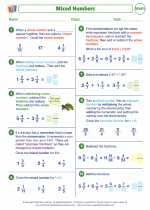Fractions
A fraction represents a part of a whole. It consists of a numerator (the top number) and a denominator (the bottom number). The numerator represents the number of parts we have, and the denominator represents the total number of parts that make up a whole.
Types of Fractions
- Proper Fraction: A fraction where the numerator is less than the denominator, such as 1/2 or 3/4.
- Improper Fraction: A fraction where the numerator is greater than or equal to the denominator, such as 5/3 or 7/4.
- Mixed Number: A whole number combined with a proper fraction, such as 2 1/3.
Equivalent Fractions
Equivalent fractions are different fractions that represent the same value. To find equivalent fractions, we can multiply or divide both the numerator and denominator by the same number.
Adding and Subtracting Fractions
When adding or subtracting fractions, the denominators must be the same. If they are not the same, we need to find a common denominator first. Once the denominators are the same, we can add or subtract the numerators and keep the denominator the same.
Multiplying and Dividing Fractions
When multiplying fractions, we simply multiply the numerators together to get the new numerator, and multiply the denominators together to get the new denominator. When dividing fractions, we multiply by the reciprocal of the second fraction (flipping the numerator and denominator) and then multiply as we do for multiplication.
Study Guide
To study fractions, make sure to understand the concept of parts of a whole, the relationship between the numerator and denominator, and the different types of fractions. Practice finding equivalent fractions, adding, subtracting, multiplying, and dividing fractions. Mastering fractions can be challenging, so practice is key to success.
Remember to simplify fractions by dividing both the numerator and denominator by their greatest common divisor. Also, practice converting between mixed numbers and improper fractions.
Finally, don't forget to apply fractions to real-life situations, such as measuring ingredients for a recipe, dividing a pizza among friends, or calculating discounts while shopping. This will help reinforce your understanding of fractions in practical scenarios.
[Fractions] Related Worksheets and Study Guides:
.◂Math Worksheets and Study Guides Sixth Grade. Mixed Numbers
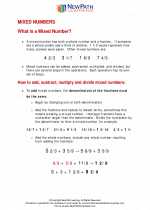
 Worksheet/Answer key
Worksheet/Answer key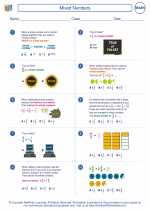
 Worksheet/Answer key
Worksheet/Answer key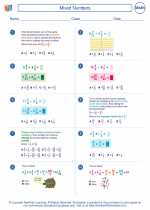
 Worksheet/Answer key
Worksheet/Answer key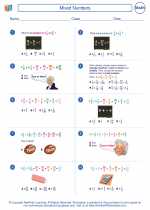
 Worksheet/Answer key
Worksheet/Answer key